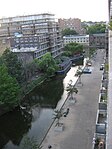City Road Basin
Canal basins in England and WalesCanals opened in 1820London docksRegent's CanalUse British English from January 2018

The City Road Basin is an English canal basin and part of the Regent's Canal in Central London, owned by the Canal & River Trust. It opened in 1820, and made a large contribution to the prosperity of the Regent's Canal. By the 1950s, its surroundings were largely derelict, but a programme of regeneration began in 2004, involving several large-scale residential developments, and public access to the basin was provided for the first time in 2009. The basin is used for canoeing by the Islington Boat Club.
Excerpt from the Wikipedia article City Road Basin (License: CC BY-SA 3.0, Authors, Images).City Road Basin
Graham Street, London Finsbury (London Borough of Islington)
Geographical coordinates (GPS) Address Nearby Places Show on map
Geographical coordinates (GPS)
| Latitude | Longitude |
|---|---|
| N 51.53114 ° | E -0.097321 ° |
Address
Regents Canoe Club & Islington Boat Club
Graham Street
N1 8JX London, Finsbury (London Borough of Islington)
England, United Kingdom
Open on Google Maps









